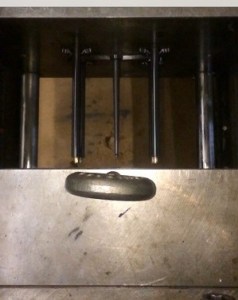 One of our customers approached Toth Mold/Die Inc. with a request to produce a 5 in. long tube with a .375 in. o.d. x .265 in. i.d. using the injection molding process. The reason for injection molding this part and not extruding it was because the length of the part had a very close tolerance and it would have to be cut with extreme precision. In addition, that also made the part cost prohibitive to produce by the extruding process. The part was an automotive part and the cost to produce this part was a huge factor. The part was to be made from a Nylon 66 material.
One of our customers approached Toth Mold/Die Inc. with a request to produce a 5 in. long tube with a .375 in. o.d. x .265 in. i.d. using the injection molding process. The reason for injection molding this part and not extruding it was because the length of the part had a very close tolerance and it would have to be cut with extreme precision. In addition, that also made the part cost prohibitive to produce by the extruding process. The part was an automotive part and the cost to produce this part was a huge factor. The part was to be made from a Nylon 66 material.
There were a number of issues to contend with in order to produce this part. The biggest issue was maintaining the .055 in. wall and preventing the .265 in. core from deflecting. This core needed to be standing 5 in. To prevent the core from deflecting and also bending during the injection phase of the cycle, I had to pilot the core into a hole at the bottom of the cavity and also use two gates. I forgot to mention that the part was not permitted have any taper on the i.d. or o.d. so ejecting the part seemed impossible since the ejector movement needed to be over 5 in. After some time of thinking about the best way to eject this part, I came up with a way to do it but I was not 100% sure it was going to work. Building a mold and not being 100% sure that it was going to function is a big gamble. Also, if it did not work, there would need to be another solution which would be almost impossible to do without doing a whole redesign.
This part is injection molded without an ejector! Without divulging the whole design this is the sequence of the injection molding cycle of the part. Mold closes and goes through the filling and cooling phase. When the mold starts to open the parts stay on the core. Once the mold opens 5 in. and the parts are completely out of the cavity, the parts begin to be stripped off the cores. By the time the mold is completely opened, the parts are already done being ejected which also eliminates the need for the ejector phase of the cycle. This means the overall cycle time is also reduced.
The mold worked on the first shot and has been running for over 7 years. Venting, core material and water was also a big part in the mold design. This mold is a four cavity mold and the length tolerance is +/- .006 in.
Toth Mold/Die Inc. thrives for these kinds of challenges. If someone tells you “it cannot be done” bring it to us and we will make it happen.
